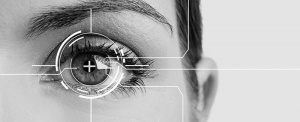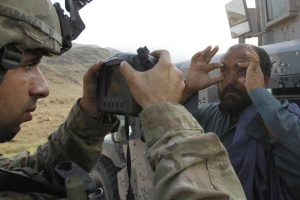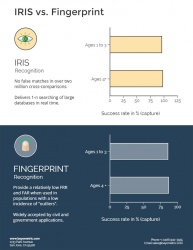Iris Recognition
Iris recognition is a biometric verification method that utilizes the unique pattern of an individual's iris, the colored circular structure in the eye, to confirm one’s identity. The authentication process begins by scanning an iris at a reasonable distance with near-infrared light to construct a template and comparing the acquired template to the individual's already existing templates in a database[1].
Similar to face recognition and fingerprinting, iris recognition uses human biological characteristics to distinguish one person from another for security purposes and efficiency. It is sometimes preferred over both face recognition and fingerprinting techniques due to the more unique structural attributes of the iris. As iris recognition is becoming more widely used, ethical concerns of identity, privacy, and consent have also come into view.

Contents
History
John Daugman is the first person credited with creating iris recognition algorithms with the ability to be used in new technologies. In his paper, "How iris recognition works", his statistical analysis of iris patterns successfully distinguished and identified individuals and with high accuracy[3]. These findings paved the way for iris recognition technologies to be used by companies across different industries. Currently, the companies Iris ID Systems, CMITECH, Princeton Identity, Sensor Access Technology, Argus Global Limited, and EFG GZ all specialize in recognition technology utilizing some version of these iris identification algorithms[4].
Since the adoption of iris recognition technology and the value of being able to produce it has risen, iris recognition has found many different usages with potential for monetary gains. Banks and various financial institutions have implemented iris scanning over other more traditional forms of authentication due to its convenience of use and higher security[5]. Phone companies like Samsung have even employed iris scanning as a means of accessing one's phone. This technology has also been found to be increasingly helpful in law and border enforcement agencies, which prioritize quickly and correctly identifying individuals[5].
Examples
TSB Bank in the United Kingdom was one of the first banks, in September 2016, to incorporate Iris Recognition into their day to day banking operations. In order to log into the TSB application, you are now able to just glance at your mobile device. Iris Recognition is the next step in login technology after mobile fingerprints. Compared to the four traits the fingerprint scans for, Iris recognition is able to recognize two hundred and sixty-six. [6]
Apple's iPhone XR includes a facial recognition software which incorporates iris recognition. Like the banks' technology, you no longer have to touch your phone to utilize the device.
Country border controls also have the ability to utilize this technology. The United Arab Emirates employs this when any passengers enter through air, land or sea. [7]
Airport Security is now utilizing iris recognition. A company called Clear has come into play in airports in attempts to simplify and save time. Customer's eyes are scanned as a means of identity verification, saving them the time of having to take out their ID and have it checked by a TSA officer.[8]
Major League Baseball games are now using this similar technology after partnering with Clear. Just as Clear is used in airports so that travelers can skip long lines, the same is going for MLB games. People can also use this technology as age verification to purchase alcohol in some stadiums. [8]
Google uses Iris Scanning as a component of its security measures used to secure its Data Centers [9]
Advantages
High Accuracy Versus Other Biometric Methods
Iris recognition is not guaranteed to be entirely correct or effective every time. Factors like lighting and different algorithms may affect accuracy. However, there is less room for deceit because it is more difficult to alter iris than other body parts. Iris traits are more permanent and stable.[10] An additional advantage of iris recognition technology is that it can also be used even when contacts are in or glasses are on.
Facial recognition has a high-error rate because facial features change across different environmental conditions and there can be almost exact faces existing among people such as identical twins.[11] Facial features may also change over time due to aging which reduces the accuracy of facial recognition technology overtime without adjustments and regular adjustments. Moreover, facial cosmetic surgery may make face recognition inaccurate and require additional adjustments. In 2018 alone, there were over 3 million facial cosmetic surgery procedures[12]
In addition to facial cosmetic surgery, there are also multiple ways of altering one’s fingerprints which creates an opportunity for ill-intentioned actors to successfully sneak through security checkpoints. According to a report in Forensic magazine, the FBI has caught hundreds of suspects who tried to alter their distinctive marks at their fingertips by deep cuts, burning, biting, or using sandpaper to avoid identification.[13] Genotypic and phenotypic methods have limitations on biometric performance, where genetic penetrance describes heritability of factors or "the extent to which the features expressed are genetically determined." For example, blood group and DNA sequence would fall under genotypic features. Phenotypic describes what genes are expressed, such as fingerprints and iris patterns. These influence two error rates, genotypic error rate, and phenotypic error rate, where theres concerns with genotypic penetrance causes a high false positive rate and phenotypic features from cause a high false negative rate.[14].
Remote Scan
The way that the iris is scanned makes iris recognition technologies more efficient than other facial recognition software. While an iris scanner only needs to convert iris patterns to data and can do so at a considerable distance, face recognition demands close-proximity in order to scan many facial parts to collect essential features, and fingerprint detection requires people to physically press their fingers onto the machines. Iris recognition is only getting more remote. Researchers at Carnegie Mellon University have increased the distance from which iris recognition is able to work to more than ten meters away from a moving subject. This means that, in the future, it is very possible that an iris recognition surveillance camera can easily identify people from a far distance: as they walk through an airport or glance into a rear-view mirror while driving.[16]
Iris Recognition vs. Fingerprinting
Iris and fingerprint scanners are both popular biometric methods used for security purposes, specifically to confirm one’s identity. Both fingerprinting and iris recognition are accurate and reliable methods because they rely on unique features to every individual [15]. Fingerprint scanners are generally more affordable and therefore are more common on personal devices. However, in regards to security, iris scanners are more favorable than fingerprinting [17]. The iris is more accurate because it remains the same throughout a person’s life, even when a person ages. The patterns that make up the iris are intricate and detailed, making it difficult to copy [17]. Alternatively, fingerprint results can be negatively effected due to skin type, environment, and age [17]. Although difficult, fingerprinting is also easier to replicate. Iris recognition is also more preferable because it is cleaner since no physical contact is necessary to acquire the results [17].
Ethical Issues
Identity
Due to the high accuracy of iris recognition, many countries including the UK and the United Arab States are currently using this technology as a national ID for citizens and as a passport for travelers. Like Wikipedia bots and cyborgs, which combat vandalism more effectively than humans (though they also can create chaos when used inappropriately by malicious users), the high accuracy of iris recognition brings about serious consequences such as the ease of identity theft by using high-resolution photos of someone else's iris.[18] It is very likely that iris recognition will become a substitute for other legal documents - like drivers’ licenses - and will be applied to any situation that requires ID. Irises are not like fake paper documents that can be assessed without much effort or pain.
Because iris recognition identifies individuals based on an unchangeable aspect of their physical identity, it proves to be extremely difficult for individuals to circumvent security checkpoints. With conversations on rights that people have to alter their identity to reflect who they are, preventing iris alterations if substituting traditional documents may restrict autonomy and while violating individual privacy despite the possible benefits of security enforcement through a more reliable enforcement system.[19] Although, colored contacts may be a way to circumvent this restriction.
Privacy

Until recently, iris recognition has been used mainly by the U.S. military to identify captives taken from foreign battlefields, police departments to surveil law-breakers, the Department of Homeland Security to spot suspects on watch lists, law enforcement at borders to identify smugglers and terrorists.[16] As more iris data is collected, and commercial iris scanners become cheaper and more accessible, iris scanning could be utilized for privacy intrusions. It may be possible that walking down in the future will expose individuals to street cameras that know each passerby's identity, acquaintances, daily routines, and more.[20] Such a use of this technology would be dangerous in the hands of organizations, governments, and malicious people that may want to hurt individuals or groups of people. Furthermore, with the improvement of resolution techniques, it could be possible to use iris recognition to match and combine someone's online and offline identities. For example, how they identify strangers by using face recognition and photos on Facebook in the paper "Face Recognition and Privacy in the Age of Augmented Reality". This sort of technology is increasingly blurring the line between people's life online and offline, and calls for our attention in solving the rising privacy matters.[21]
Consent
From a security point of view, iris records help police keep track of specific suspects that were trying to escape from charges. However, the data could be used to track defendants even after the charge is dropped or the case is closed. The United States' New York City police department faced criticism in 2010 when reports were released stating that some police officers would hold detainees longer than necessary because those people refused to have their iris photographs taken.[22] The ethical issue of collecting iris data without consent is further complicated by the lack of transparency governments and organizations often employ when handling such data. Companies and legislation that fail to display transparency and make information invisible - or difficult to access - prevent individuals from exerting control over their personal data and from consenting to the dissemination of that information.[23] Transparency enables the ethical concern of consent to persist among biometric identifiers, but groups like the Federal Trade Commission (FTC) have made efforts to improve this problem. In 2012, the FTC issued a report with recommended principles for companies and organizations to adopt such as practices related to the transparent information collection and use, the inclusion of privacy protections during product development, and providing consumers with more contextualized and timely information regarding the collection of their personal data.[24]
Reference
- ↑ Wildes, Richard. Iris Recognition: an Emerging Biometric Technology - IEEE Journals & Magazine, Sept. 1997, ieeexplore.ieee.org/stamp/stamp.jsp?tp=&arnumber=628669.
- ↑ Thakkar, Danny. “Retinal vs. Iris Recognition: Your Eyes Can Get You Identified?” Bayometric, Bayometric, 8 Aug. 2018, www.bayometric.com/retinal-vs-iris-recognition/.
- ↑ J. Daugman, "How iris recognition works," in IEEE Transactions on Circuits and Systems for Video Technology, vol. 14, no. 1, pp. 21-30, Jan. 2004. doi: 10.1109/TCSVT.2003.818350
- ↑ "Iris Recognition". IFSEC Global Directory. https://directory.ifsecglobal.com/iris-recognition-code004809.html
- ↑ 5.0 5.1 Thakkar, Danny. “Biometric Iris Recognition and Its Application.” Bayometric, Bayometric, 15 Aug. 2018, www.bayometric.com/biometric-iris-recognition-application/.
- ↑ "TSB to roll out iris scanning tech" Rory Cellan-Jones, July 20 2016. https://www.bbc.com/news/technology-40663365
- ↑ "IRIS RECOGNITION BORDER-CROSSING SYSTEM IN THE UAE"https://trid.trb.org/view/741851
- ↑ 8.0 8.1 "A Full Guide to Clear Airport Security: How It Works and Where You Can Use it" https://www.travelandleisure.com/airlines-airports/clear-airport-security
- ↑ "Security and Data Protection in a Google Data Center ", G Suite's Official YouTube https://www.youtube.com/watch?v=cLory3qLoY8
- ↑ Jain, Anil K., and Sharath Pankanti. “BEYOND FINGERPRINTING.” Scientific American, vol. 299, no. 3, 2008, pp. 78–81. JSTOR, www.jstor.org/stable/26000805.
- ↑ Daugman, John. “Iris Recognition: The Colored Part of the Eye Contains Delicate Patterns That Vary Randomly from Person to Person, Offering a Powerful Means of Identification.” American Scientist, vol. 89, no. 4, 2001, pp. 326–333. JSTOR, www.jstor.org/stable/27857501.
- ↑ “Leading Surgical Cosmetic Procedures Globally 2017 | Statistic.” Statista, www.statista.com/statistics/293437/leading-surgical-cosmetic-procedures/.
- ↑ Augenstein, Seth. “FBI Warns About Altered Fingerprints.” Forensic Magazine, 14 June 2016, www.forensicmag.com/article/2015/05/fbi-warns-about-altered-fingerprints.
- ↑ Daugman, MSU, Recognizing Persons By Their Iris Patterns http://www.cse.msu.edu/~stockman/Book/projects.html/F09Docs/Readings/daugemanRecognizingPersons.pdf
- ↑ 15.0 15.1 Thakkar, Danny. “Iris Recognition Scanners vs. Fingerprint Scanners.” Bayometric, Bayometric, 15 Aug. 2018, www.bayometric.com/iris-recognition-scanners-vs-fingerprint-scanners/
- ↑ 16.0 16.1 16.2 Stone, Jeff. “Iris Scanners, Widely Used By US Military, Could Be Coming To A Police Department Near You.” International Business Times, 12 May 2015, www.ibtimes.com/iris-scanners-widely-used-us-military-could-be-coming-police-department-near-you-1917018.
- ↑ 17.0 17.1 17.2 17.3 Hassan, Mehedi, et al. “Iris Recognition Is Most Accurate Biometric Modality.” M2SYS Blog On Biometric Technology, 5 Feb. 2019, www.m2sys.com/blog/biometric-hardware/reliable-biometric-modality/.
- ↑ Halfaker, Aaron, and John Riedl. “Bots and Cyborgs: Wikipedia's Immune System.” Computer, vol. 45, no. 3, 2012, pp. 79–82., doi:10.1109/mc.2012.82.
- ↑ Information Technology and Moral Philosophy "Plural Selves and Relational Identity" Dean Docking 2008
- ↑ Meyer, Robinson. “Long-Range Iris Scanning Is Here (and It's Creepy).” The Atlantic, Atlantic Media Company, 13 May 2015, www.theatlantic.com/technology/archive/2015/05/long-range-iris-scanning-is-here/393065/.
- ↑ Acquisti, A., R. Gross, and F. Stutzman. “Face Recognition and Privacy in the Age of Augmented Reality”. Journal of Privacy and Confidentiality, Vol. 6, no. 2, Dec. 2014, doi:10.29012/jpc.v6i2.638.
- ↑ Moynihan, Colin. “Some Who Decline an Optional Iris Photo Are Kept Longer in Jail, Critics Say.” The New York Times, The New York Times, 13 Feb. 2012, www.nytimes.com/2012/02/13/nyregion/new-objections-to-nypds-iris-photographing-program.html.
- ↑ Turilli, M. & Floridi, L., "The ethics of information transparency", March 2009, p. 105-112
- ↑ United States Government Accountability Office, "Facial Recognition Technology", July 2015, p. 23-24
